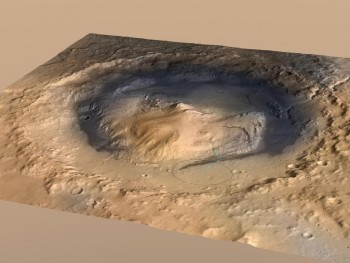Miles-High Mars Mounds Built by Wind
October 11, 2016

New research has found that wind carved massive mounds of more than a mile high on Mars over billions of years. The findings, published in Geophysical Research Letters on March 31, 2016, show the importance of wind in shaping the Martian landscape, said lead author Mackenzie Day, a graduate student at the Jackson School of Geosciences.
“On Mars there are no plate-tectonics, and there’s no liquid water, so you don’t have anything to overprint that signature and over billions of years you get these mounds,” Day said. “Wind could never do this on Earth because water acts so much faster, and tectonics act so much faster.”
Jackson School professors Gary Kocurek and David Mohrig of the Department of Geological Sciences and University of Texas at Dallas researcher William Anderson also worked on the study.
Recent analysis by the Mars rover Curiosity of Mount Sharp, a mound over three miles high inside Gale Crater, has revealed that the thickest mounds are made of sedimentary rock, with bottoms made of sediments carried by water that used to flow into the crater and tops made of sediments deposited by wind.
However, how the mounds formed inside craters that were once full of sediments was an open question. To test whether wind could create a mound, the researchers built a miniature crater 30 centimeters wide and 4 centimeters deep, filled it with damp sand, and placed it in a wind tunnel. The model’s sediment eroded into forms similar to those observed in Martian craters.
The research was funded by NASA, the National Science Foundation and The University of Texas at Dallas.
Back to the Newsletter